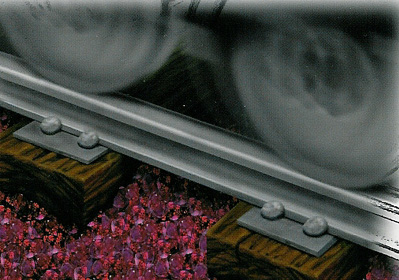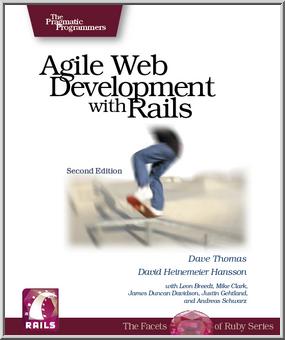Ruby on Rails
I did not know what “ruby” means in English. And though in Russian it is almost the same word for red gemstone — “rubin” — I thought that Ruby is a male name like Robby, Rudy or Eddie.
That’s why when I heard about Ruby on Rails my mind was always drawing the picture of a developer (Rudy, Robby, Eddie) who builds infrastructure (Rails) for dynamic projects.
Yes, like this:

Then I finally found out that Ruby is a programming language named after the gemstone; and that my imaginary Rudy is David Hansson, who used Ruby for a web application framework and named it Ruby on Rails. Since that name is quite long and clumsy it is usually shortened to Rails.
This post is actually about two guides on Rails. Precisely about two covers of almost the same guide.

The Illustration on the “Agile Web Development with Rails” guide published in 2005 charms: A swift train whirls away on rails laid over billions of red gemstones — a ruby railroad! It can be read as the best road ever, as the most reliable and durable. At the same time an uncountable amount of sparkling treasures is making this road look expensive and luxurious, like it was built for a sultan. This may be positive characteristics, but not when open source software for the web is concerned.
To quote from the second edition of the book from the end of 2006: “Rails makes it both fun and easy to turn out very cool web applications.” There are no precious elements on the cover any more, but a street and a skateboard and a swift boy (Rudy, Robby or Eddie).

I guess it was also a good idea of the book designer to switch the rail metaphor to another meaning and move the action to open, public spaces where boys and girls grind on rails. And, if I’m allowed to continue to interpret the cover and elaborate more on developer as a skateboarder, it says that you are free to jump off the rails and continue wherever you like and on what ever comes next or already exists.
And! Looking at Ruby books I found a perfect place for the analogy with change of the wheels boogie. That picture had to be on the cover of just published guide on “How to translate your hard-earned Java knowledge and skills into the world of Ruby and Rails”. Maybe in the next edition.
I was going to get that book, didn’t know there was a previous edition, cause I am studying ruby on rails
the framework itself uses the word “scaffold” to name the operation that builds the models, controllers, helpers and views from your database model
the problem I have with rails is that it doesn’t run on just any host, and specially, not my current one
ah, I got the book now
having looked more closely at the picture I think it is meant to emphasize on the “agile” (have a look at the manifesto) and also the first edition of the book was made when rails was very new and people needed to be reassured that it was all sturdy as a train… now that ruby on rails is at version 1.2 (wow!) and they claim the book had to be completely rewritten the emphasis can brought back on lightness